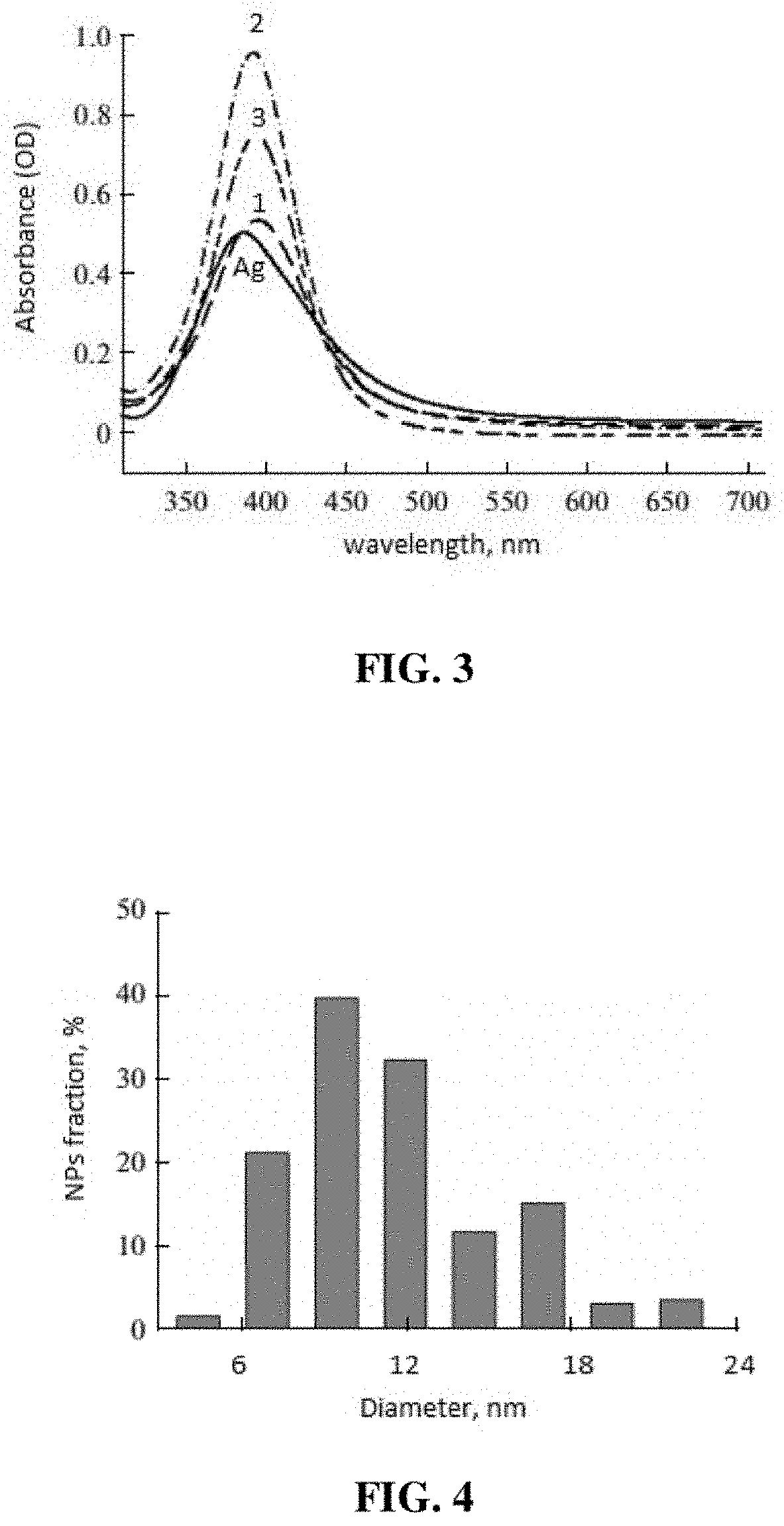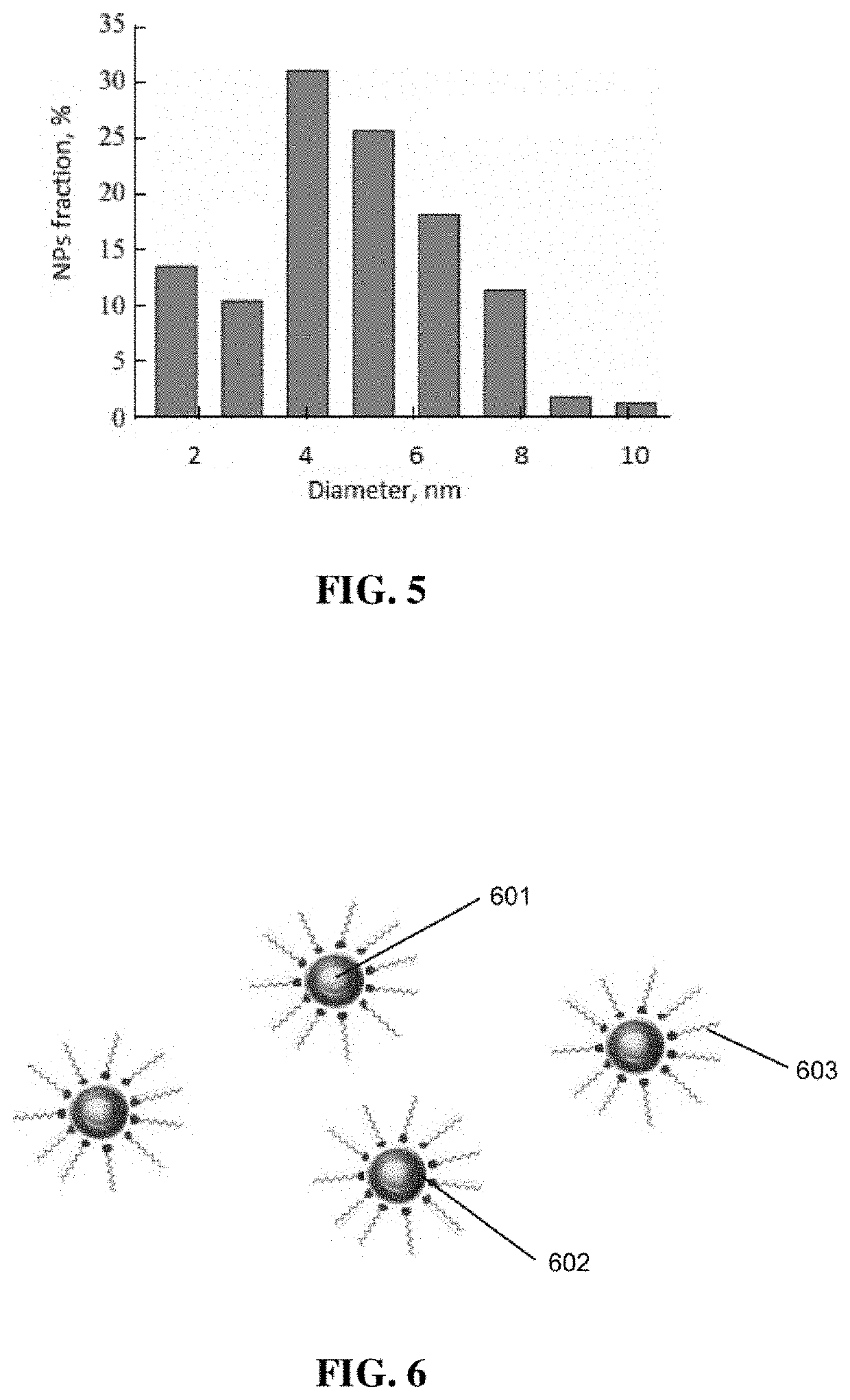Nanoparticle composition and method of use and manufacture
- Summary
- Abstract
- Description
- Claims
- Application Information
AI Technical Summary
Benefits of technology
Problems solved by technology
Method used
Image
Examples
example 1
Nanoparticle Preparation—Bimetallic Nanoparticle Composition Having Miramistin®
[0082]A composition of silver and gold bimetallic nanoparticles with (Miramistin®) was prepared as follows: aqueous solutions of silver and gold salts were added to a solution of at least one surfactant under vigorous stirring, then a reducing agent was added. The reaction was carried out in an inert atmosphere of nitrogen or argon. Silver nitrate or silver acetate can be used as the silver salt, and hydrogen tetrachloroaurate as a source of gold.
[0083]The following procedure was used for the preparation of Sample 1-2. Samples 1-3 and 1-4 were prepared according to the same procedure, with adjustments made to the amounts of the metal-bearing components to achieve the molar percentages of the respective samples. Distilled water was repeatedly distilled in the atmosphere of nitrogen gas to achieve de-oxygenation. The de-oxygenized water was used for all further preparations. Aqueous solutions of 20 mg silve...
example 2
Nanoparticle Characterization—Bimetallic Nanoparticle Composition Having Miramistin®
[0086]UV-V is absorption spectra were measured to confirm nanoparticle formation. FIG. 3 shows the absorption spectra of the nanoparticles in the resulting compositions. Incorporation of gold affects the dispersity of nanoparticles in the final product, the absorption spectra of bimetallic particles displayed more intense, narrow and symmetrical absorption bands. At 0.5% gold molar content, the nanoparticles of Sample 1-3 had the least dispersity. The dispersity difference between Samples 1-1 and 1-3 is clearly seen in FIG. 1 (Sample 1-1) and FIG. 2 (Sample 1-3).
[0087]For a more accurate estimation of the nanoparticle size distribution of silver particle sizes versus bimetallic nanoparticles, dynamic light scattering was applied. The average diameter of silver monometallic nanoparticles (Sample 1-1) was 9-10 nm (FIG. 4), while the bimetallic nanoparticles of Sample 1-3 were smaller at 5-6 nm (FIG. 5)...
example 3
Antimicrobial and Cytotoxic Properties—Bimetallic Nanoparticle Composition with Miramistin®
[0088]Minimum inhibitory concentration (MIC) was determined to assess antibacterial and antifungal activities of the samples in microorganisms. MIC is the lowest concentration of a drug, which prevents visible growth of bacterium. The tested panel of microorganisms represent a very broad spectrum of microorganisms, including Gram-positive and Gram-negative strains (Staphylococcus aureus vs. Escherichia coli), methicillin resistant strain INA 00761 (Staphylococcus aureus), vancomycin resistant strain VKPM B-4177 (Leuconostoc mesenteroides), fungi strain INA 00760 (Aspergillus niger), and yeast strain RIA259 (Saccharomyces cerevisiae). The results obtained are presented in Table 2.
TABLE 2SilverNitrateMiramistin ®Sample 1-1Sample 1-3MicroorganismMIC, ug / mLEscherichia coli102010.5ATCC 25922Staphylococcus20551aureus FDA 209PLeuconostoc51055VKPMB-4177Staphylococcus5102.50.5aureus INA00761Saccharomyc...
PUM
| Property | Measurement | Unit |
|---|---|---|
| Fraction | aaaaa | aaaaa |
| Fraction | aaaaa | aaaaa |
| Fraction | aaaaa | aaaaa |
Abstract
Description
Claims
Application Information
 Login to View More
Login to View More - R&D
- Intellectual Property
- Life Sciences
- Materials
- Tech Scout
- Unparalleled Data Quality
- Higher Quality Content
- 60% Fewer Hallucinations
Browse by: Latest US Patents, China's latest patents, Technical Efficacy Thesaurus, Application Domain, Technology Topic, Popular Technical Reports.
© 2025 PatSnap. All rights reserved.Legal|Privacy policy|Modern Slavery Act Transparency Statement|Sitemap|About US| Contact US: help@patsnap.com



